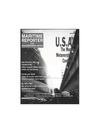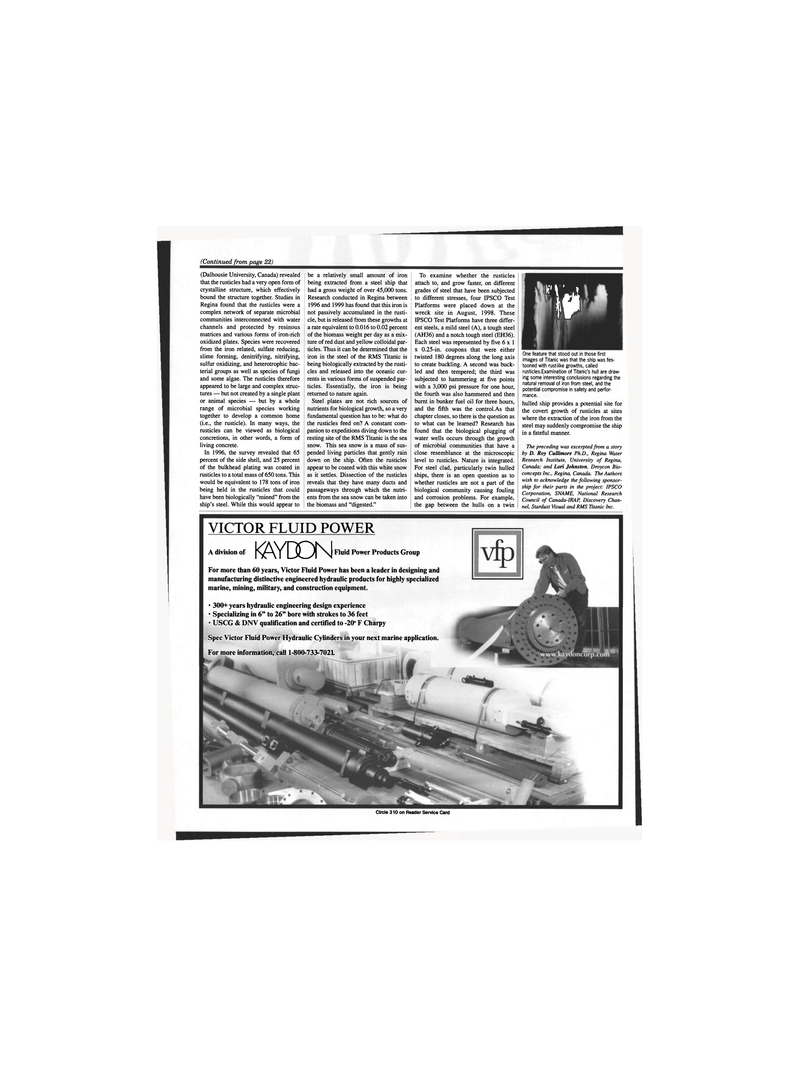
Page 66: of Maritime Reporter Magazine (August 1999)
Read this page in Pdf, Flash or Html5 edition of August 1999 Maritime Reporter Magazine
(Continued from page 22) (Dalhousie University, Canada) revealed that the rusticles had a very open form of crystalline structure, which effectively bound the structure together. Studies in
Regina found that the rusticles were a complex network of separate microbial communities interconnected with water channels and protected by resinous matrices and various forms of iron-rich oxidized plates. Species were recovered from the iron related, sulfate reducing, slime forming, denitrifying, nitrifying, sulfur oxidizing, and heterotrophic bac- terial groups as well as species of fungi and some algae. The rusticles therefore appeared to be large and complex struc- tures — but not created by a single plant or animal species — but by a whole range of microbial species working together to develop a common home (i.e., the rusticle). In many ways, the rusticles can be viewed as biological concretions, in other words, a form of living concrete.
In 1996, the survey revealed that 65 percent of the side shell, and 25 percent of the bulkhead plating was coated in rusticles to a total mass of 650 tons. This would be equivalent to 178 tons of iron being held in the rusticles that could have been biologically "mined" from the ship's steel. While this would appear to be a relatively small amount of iron being extracted from a steel ship that had a gross weight of over 45,000 tons.
Research conducted in Regina between 1996 and 1999 has found that this iron is not passively accumulated in the rusti- cle, but is released from these growths at a rate equivalent to 0.016 to 0.02 percent of the biomass weight per day as a mix- ture of red dust and yellow colloidal par- ticles. Thus it can be determined that the iron in the steel of the RMS Titanic is being biologically extracted by the rusti- cles and released into the oceanic cur- rents in various forms of suspended par- ticles. Essentially, the iron is being returned to nature again.
Steel plates are not rich sources of nutrients for biological growth, so a very fundamental question has to be: what do the rusticles feed on? A constant com- panion to expeditions diving down to the resting site of the RMS Titanic is the sea snow. This sea snow is a mass of sus- pended living particles that gently rain down on the ship. Often the rusticles appear to be coated with this white snow as it settles. Dissection of the rusticles reveals that they have many ducts and passageways through which the nutri- ents from the sea snow can be taken into the biomass and "digested."
To examine whether the rusticles attach to, and grow faster, on different grades of steel that have been subjected to different stresses, four IPSCO Test
Platforms were placed down at the wreck site in August, 1998. These
IPSCO Test Platforms have three differ- ent steels, a mild steel (A), a tough steel (AH36) and a notch tough steel (EH36).
Each steel was represented by five 6x1 x 0.25-in. coupons that were either twisted 180 degrees along the long axis to create buckling. A second was buck- led and then tempered; the third was subjected to hammering at five points with a 3,000 psi pressure for one hour, the fourth was also hammered and then burnt in bunker fuel oil for three hours, and the fifth was the control.As that chapter closes, so there is the question as to what can be learned? Research has found that the biological plugging of water wells occurs through the growth of microbial communities that have a close resemblance at the microscopic level to rusticles. Nature is integrated.
For steel clad, particularly twin hulled ships, there is an open question as to whether rusticles are not a part of the biological community causing fouling and corrosion problems. For example, the gap between the hulls on a twin h' i #
One feature that stood out in those first images of Titanic was that the ship was fes- tooned with rust-like growths, called rusticles.Examination of Titanic's hull are draw- ing some interesting conclusions regarding the natural removal of iron from steel, and the potential compromise in safety and perfor- mance. hulled ship provides a potential site for the covert growth of rusticles at sites where the extraction of the iron from the steel may suddenly compromise the ship in a fateful manner.
The preceding was excerpted from a story by D. Roy Cullimore Ph.D., Regina Water
Research Institute, University of Regina,
Canada; and Lori Johnston, Droycon Bio- concepts Inc., Regina, Canada. The Authors wish to acknowledge the following sponsor- ship for their parts in the project: IPSCO
Corporation, SNAME, National Research
Council of Canada-IRAP, Discovery Chan- nel, Stardust Visual and RMS Titanic Inc.
VICTOR FLUID POWER
Circle 310 on Reader Service Card
KAYDON A division of Fluid Power Products Group
For more than 60 years, Victor Fluid Power has been a leader in designing and manufacturing distinctive engineered hydraulic products for highly specialized marine, mining, military, and construction equipment. • 300+ years hydraulic engineering design experience • Specializing in 6" to 26" bore with strokes to 36 feet • USCG & DNV qualification and certified to -20° F Charpy
Spec Victor Fluid Power Hydraulic Cylinders in your next marine application.
For more information, call 1-800-733-7021

 65
65

 67
67
